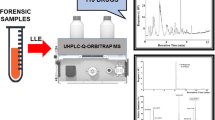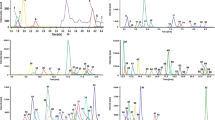Abstract
A rapid and sensitive high-performance liquid chromatography–high-resolution orbitrap mass spectrometry method was developed for the simultaneous screening of 354 organic poisons and metabolites in blood and urine, including drugs, medications, pesticides, rodenticides, veterinary drugs, alkaloids, and mycotoxins with a multi-toxicant chromatography-mass spectrometry information library. The method and library showed good prospects in clinical poisoning screening and forensic toxicological identification. Blood and urine samples were extracted successively with ethyl acetate in acidic and alkaline conditions; then, the extract was blown to nearly dry by nitrogen gas and redissolved with methanol-aqueous solution (v:v, 50:50), and the dissolved solution was analyzed by LC-MS/MS after filtering. Precursor ions’ m/z was set for identification, retention time, fragment ions, and isotopic pattern which were used for confirmation. No interference peaks were found in the blank samples, showing good specificity. The LODs of toxicants in urine and blood were 1.00×10−3–50.0 ng/mL and 2.07×10−3–50.0 ng/mL, respectively, while the LOQs were 3.30×10−3–1.67×102 ng/mL and 6.91×10−3–1.67×102 ng/mL. The intra-day precision and inter-day precision of urine samples were 2.31–9.13% and 4.75–12.3%, respectively, which were 1.92–10.8% and 2.01–12.1% in blood samples. The established method was applied to analyze 9 cases of clinical poisoning patients, and bromadiolone, carbofuran, and amanitins were detected, respectively. A total of 382 biospecimens from drug abusers were analyzed with the proposed method, which indicated that some drugs were detected in 62 cases, mainly including methamphetamine, heroin, and MDMA. The results were consistent with the information from traditional liquid chromatography-triple quadrupole mass spectrometry.
Graphical abstract








Similar content being viewed by others
Change history
06 December 2022
A Correction to this paper has been published: https://doi.org/10.1007/s00216-022-04470-0
References
Organization WH. The public health impact of chemicals: knowns and unknowns - data addendum for 2019 2021 [cited 2021 12-26]. Available from: https://www.who.int/publications/i/item/WHO-HEP-ECH-EHD-21.01
Shengdi L, Bin H, Jinsong Z, Jinru L, Hua L, Yong M. An epidemiology analysis of acute poisoning in China in 2012-2016. J Clin Emerg. 2018;19(8):528–32.
Gummin DD, Mowry JB, Beuhler MC, Spyker DA, Bronstein AC, Rivers LJ, et al. 2020 Annual Report of the American Association of Poison Control Centers’ National Poison Data System (NPDS): 38th Annual Report. Clin Toxicol. 2021;59(12):1282–501.
Centre-North PI. Annual report 2019(General report) 2020 [cited 2021 12-26]. Available from: https://www.giz-nord.de/php/images/downloads/jahresberichte/2019/jabe19d.pdf
Duverneuil C, de la Grandmaison GL, de Mazancourt P, Alvarez J-C. A high-performance liquid chromatography method with photodiode-array UV detection for therapeutic drug monitoring of the nontricyclic antidepressant drugs. Ther Drug Monit. 2003;25(5).
Herzler M, Herre S, Pragst F. Selectivity of substance identification by HPLC-DAD in toxicological analysis using a UV spectra library of 2682 compounds. J Anal Toxicol. 2003;27(4):233–42.
Valenta H. Chromatographic methods for the determination of ochratoxin A in animal and human tissues and fluids. J Chromatogr A. 1998;815(1):75–92.
Abdel-Hamid ME. Comparative LC–MS and HPLC analyses of selected antiepileptics and beta-blocking drugs. Il Farmaco 2000;55(2):136-145.
Walravens J, Mikula H, Rychlik M, Asam S, Devos T, Njumbe Ediage E, et al. Validated UPLC-MS/MS methods to quantitate free and conjugated Alternaria toxins in commercially available tomato products and fruit and vegetable juices in Belgium. J Agric Food Chem. 2016;64(24):5101–9.
Slobodchikova I, Vuckovic D. Liquid chromatography – high resolution mass spectrometry method for monitoring of 17 mycotoxins in human plasma for exposure studies. J Chromatogr A. 2018;1548:51–63.
Rezazadeh M, Yamini Y, Seidi S. Application of a new nanocarbonaceous sorbent in electromembrane surrounded solid phase microextraction for analysis of amphetamine and methamphetamine in human urine and whole blood. J Chromatogr A. 2015;1396:1–6.
Xiong J, Chen J, He M, Hu B. Simultaneous quantification of amphetamines, caffeine and ketamine in urine by hollow fiber liquid phase microextraction combined with gas chromatography-flame ionization detector. Talanta. 2010;82(3):969–75.
Pan M, Xiang P, Yu Z, Zhao Y, Yan H. Development of a high-throughput screening analysis for 288 drugs and poisons in human blood using Orbitrap technology with gas chromatography-high resolution accurate mass spectrometry. J Chromatogr A. 2019;1587:209–26.
Woźniak MK, Wiergowski M, Aszyk J, Kubica P, Namieśnik J, Biziuk M. Application of gas chromatography–tandem mass spectrometry for the determination of amphetamine-type stimulants in blood and urine. J Pharm Biomed Anal. 2018;148:58–64.
Jinlei L, Wurita A, Xuejun W, Hongkun Y, Jie G, Liqin C. Supramolecular solvent (SUPRASs) extraction method for detecting benzodiazepines and zolpidem in human urine and blood using gas chromatography tandem mass spectrometry. Legal Med. 2021;48:101822.
Turner NW, Subrahmanyam S, Piletsky SA. Analytical methods for determination of mycotoxins: a review. Anal Chim Acta. 2009;632(2):168–80.
FAN TSL, ZHANG GS, CHU FS. An indirect enzyme-linked immunosorbent assay for T-2 toxin in biological fluids. J Food Prot. 1984;47(12):964–7.
Cheng J, Wang S, Zhang S, Wang P, Xie J, Han C, et al. Rapid and sensitive determination of clenbuterol residues in animal urine by surface-enhanced Raman spectroscopy. Sensors Actuators B Chem. 2019;279:7–14.
Armenta S, Garrigues S, de la Guardia M, Brassier J, Alcalà M, Blanco M. Analysis of ecstasy in oral fluid by ion mobility spectrometry and infrared spectroscopy after liquid–liquid extraction. J Chromatogr A. 2015;1384:1-8.
Roman M, Ström L, Tell H, Josefsson M. Liquid chromatography/time-of-flight mass spectrometry analysis of postmortem blood samples for targeted toxicological screening. Anal Bioanal Chem. 2013;405(12):4107–25.
Phillips MR, Yang G, Zhang Y, Wang L, Ji H, Zhou M. Risk factors for suicide in China: a national case-control psychological autopsy study. Lancet (London, England). 2002;360(9347):1728-36.
China MoJotPsRo. Gas chromatography-mass spectrometry method for the determination of 108 poisons (drugs) in blood and urine (SF/Z JD0107014-2015) 2015 [updated 2015-11-20; cited 2021 12-26]. Available from: http://www.moj.gov.cn/pub/sfbgw/zwfw/zwfwbgxz/202101/1565869778272044576.pdf
China MoJotPsRo. Determination of 238 poisons (drugs) in blood and urine by liquid chromatography-tandem mass spectrometry (SF/Z JD0107005-2016) 2016 [updated 2016-9-22; cited 2021 12-26]. Available from: http://www.moj.gov.cn/pub/sfbgw/zwfw/zwfwbgxz/202101/1565870205956007711.pdf
Jaeger A, Jehl F, Flesch F, Sauder P, Kopferschmitt J. Kinetics of amatoxins in human poisoning: therapeutic implications. J Toxicol Clin Toxicol. 1993;31(1):63–80.
Robinson-Fuentes VA, Jaime-Sánchez JL, García-Aguilar L, Gómez-Peralta M, Vázquez-Garcidueñas MS, Vázquez-Marrufo G. Determination of α- and β-amanitin in clinical urine samples by capillary zone electrophoresis. J Pharm Biomed Anal. 2008;47(4):913–7.
Shaozhen X, Feng L, Wusheng F, Daozhi W. Determination of amatoxins and phallotoxins in plasma and urine by ultra performance liquid chromatography-tandem mass spectrometry. Food Sci. 2018;39(22):7.
Funding
This study was supported by the Key Project of Sichuan Province Science and Technology (Grant No. 2020YFS0056).
Author information
Authors and Affiliations
Contributions
Zhuoya Li: methodology, writing — original draft. Xinyi Huang: methodology, writing — review. Xuan Wang: methodology, data curation. Jianwei Ren: methodology, data curation. Buyi Xu: resources, validation. Chunying Luo: validation. Yanjun Wang: resources. Lian Wang: instrument operation. Kouji Harada: Writing — review and editing. Xiaoli Zou: conceptualization, funding acquisition.
Corresponding authors
Ethics declarations
Ethical approval
As this study does not involve any work on humans or animals, no study-specific approval by the appropriate ethics committee was required.
Competing interests
The authors declare no competing interests.
Additional information
Publisher’s note
Springer Nature remains neutral with regard to jurisdictional claims in published maps and institutional affiliations.
The original online version of this article was revised: First and last name of “Harada Kouji” were interchanged. Middle initial was also not included. It should be “Kouji H. Harada
Supplementary Information
ESM 1
(PDF 385 kb)
Rights and permissions
Springer Nature or its licensor (e.g. a society or other partner) holds exclusive rights to this article under a publishing agreement with the author(s) or other rightsholder(s); author self-archiving of the accepted manuscript version of this article is solely governed by the terms of such publishing agreement and applicable law.
About this article
Cite this article
Li, Z., Huang, X., Wang, X. et al. Establishment and application of a screening method for 354 organic toxicants in blood and urine with high-performance liquid chromatography–high-resolution orbitrap mass spectrometry. Anal Bioanal Chem 415, 493–507 (2023). https://doi.org/10.1007/s00216-022-04432-6
Received:
Revised:
Accepted:
Published:
Issue Date:
DOI: https://doi.org/10.1007/s00216-022-04432-6




